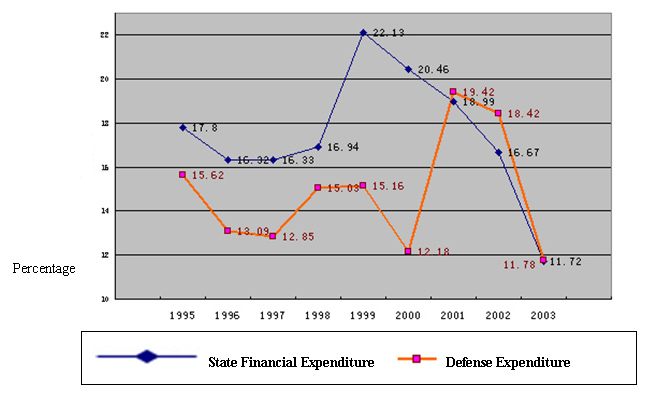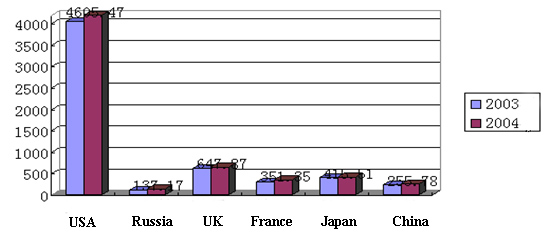|
China's National Defense in 2004
Updated: 2004-12-28 09:52
Chapter IV Defense Expenditure and Defense Assets
China manages and uses its defense funds, ensures the procurement and supply
of its military equipment and materials, and protects its defense assets in
conformity with legal provisions and in accordance with the needs of national
defense building and the requirements of the socialist market economy.
Defense Expenditure
Pursuant to The National Defense Law, the Chinese government follows the
guiding principle of the coordinated development of national defense and
economy. Based on the economic development and revenue growth, it has continued
to increase its defense expenditure moderately so as to keep up with the changes
in the demands of national defense. China's GDP in 2002 and 2003 was 10,517.234
billion yuan and 11,725.194 billion yuan respectively. Its defense expenditure
in 2002 and 2003 was 170.778 billion yuan and 190.787 billion yuan respectively.
Its defense budget for 2004 is 211.701 billion yuan.
The increased part of China's defense expenditure has primarily been used for
the following purposes: (1) Increase of the salaries and allowances of the
military personnel. It is necessary to raise the salaries and allowances of the
military personnel in step with the socio-economic development and the
per-capita income rise of urban and rural residents. In the light of the unified
wage adjustment policy for the personnel of state organs, China has raised the
salary rates of officers, civil cadres and non-commissioned officers; the
allowances of conscripts and cadets under the supply system; and the pensions of
the retired. (2) Further improvement of the social insurance system for
servicemen. In December 2003, the Provisional Measures on Social Insurance for
Unemployed Accompanying Spouses of PLA Servicemen was formulated, to guarantee
their basic living standard and provide them with social insurance subsidies.
(3) Support for the structural and organizational reform of the military. China
once again downsizes its military by 200,000, and has to increase the expenses
on the resettlement of the discharged surplus personnel accordingly. (4)
Increased investment in the development of high-caliber talents in the military.
The PLA has established and refined an incentive mechanism for talented people,
improved conditions in military educational institutions, and entrusted
non-military colleges and universities with the education of qualified
personnel, so as to ensure the achievement of the PLA's Strategic Project for
Talented People. (5) Moderate increase of equipment expenses. This is aimed at
promoting the leapfrog development of weaponry and equipment, and stepping up
preparations for military struggle.
In the past two years, the percentages of China's annual defense expenditure
to its GDP and to the state financial expenditure in the same period have
remained basically stable. For most of the years since the 1990s, the growth
rate of China's defense expenditure has been lower than that of the state
financial expenditure.
The absolute amount of China's defense expenditure has long been lower than
those of some major Western countries, and the proportion to the GDP and state
financial expenditure has also been relatively low. In 2003, China's defense
expenditure amounted to only 5.69 percent of that of the United States, 56.78
percent of that of Japan, 37.07 percent of that of the United Kingdom, and 75.94
percent of that of France.
The management of China's defense funds has become more transparent and
standardized, and its cost-effectiveness has been steadily improving. The
budgeting reform for defense expenditure has been further deepened, and a new
defense budgeting system established, which introduces the zero-base budgeting
method and united budgeting system. The budget adjustment and control function
has been strengthened, and the input direction and amountof defense funds
optimized. The tendering and bidding system for the procurement of defense
materials, projects and services has been improved, and the scope of centralized
payment extended.
Table 1: Percentage of China's Annual Defense Expenditure in Its GDP
(1997-2003)
Year
|
1997 |
1998 |
1999 |
2000 |
2001 |
2002 |
2003 |
| Percentage |
1.09 |
1.19 |
1.31 |
1.35 |
1.48 |
1.62 |
1.63 |

Chart 1: Comparison Between the Growth Rate of China's Defense expenditure
and That of Its State Financial Expenditure (1995-2003)

Chart 2: Comparison of the Defense Expenditures of Some Countries in 2003 and
2004 (unit: billion US dollars)
Note 1: Statistics in the charts are sourced from the national defense
reports, financial reports and other government reports published by the said
countries.
Note 2: The average exchange rate in 2003 was US$ 1.0 ¡Ö RMB 8.2770. On Nov.
20, 2004, US$ 1.0 ¡Ö RMB 8.2765.
Table 2: The Percentages of the Defense Expenditures in the GDP and Financial
Expenditures of Some Countries in 2003
Country
|
USA |
Russia |
UK |
France |
Japan |
China |
| Defense Expenditure as % of
GDP |
3.60 |
2.64 |
3.11 |
2.22 |
0.99 |
1.63 |
| Defense Expenditure as % of
Financial Expenditure |
16.20 |
14.69 |
8.10 |
11.00 |
6.06 |
7.74 |
Chart 3: China's Defense Expenditure, 2003 by Proportion
(unit: RMB billion yuan)
Military Order Placement and
Procurement
China practices a state ordering system to guarantee the
procurement and provision of weapons, equipment and military materials. The
General Armaments Department is responsible for the procurement of weaponry and
equipment while the General Logistics Department is in charge of the procurement
of military materials.
In October 2002, the CMC promulgated the Regulations on
the Armaments Procurement of the PLA. In December 2003, the General Armaments
Department issued relevant provisions, including the Provisions on the
Management of Armaments Procurement Plans, the Provisions on the Management of
Armaments Procurement Contracts, the Provisions on the Management of Armaments
Procurement Modes and Procedures, the Provisions on the Management of the
Examination of the Qualifications of Armaments Manufacturing Units and the
Provisions on the Management of the Centralized Procurement of Armaments of the
Same Kind. All these regulations and provisions constitute a new statutory
system for the procurement of armaments. In recent years, the procurement of
armaments has followed the basic principles of the government procurement
system, gradually pulled down the sectional barriers in military industry,
introduced the mechanism of competition and supported state-owned enterprises
outside the military industry and private high-tech enterprises to enter the
market of military products. The procurement mode has been in an accelerating
transition from procurement at designated enterprises to multiple ways of
procurement such as open bidding, invited bidding, competitive bargaining and
inquiry procurement. This has raised the overall cost-effectiveness of armaments
procurement and ensured the procurement at reasonable prices of weapons and
equipment advanced in performance, superior in quality and complete as a set.
The procurement of military computers and network devices, vehicle chassis,
generating sets, shelters, and other types of general-purpose equipment has
changed from separate to centralized procurement at the PLA level.
Since February 2002, in accordance with the Overall Plan
for Deepening the Reform in the Procurement of Military Materials, Projects and
Services approved for distribution by the CMC, the General Logistics Department
has promulgated in succession the Provisions on the Management of the
Procurement of Military Materials, the Provisions on the Management of Inviting
Tenders for Military Materials, the Provisions on the Management of Procurement
Contracts for Military Materials, the Provisions on the Management of the Price
Review Work of Procurement Agencies of Military Materials, the Provisional
Measures for the Management of Centralized Procurement Payment of Military
Materials, Projects and Services, and the Provisions on Auditing the Procurement
of Military Materials, Projects and Services. Following the basic principles of
government procurement and taking into consideration the actual conditions of
the building and management of the armed forces, the PLA has adopted in an
all-round way a mode of procurement of military materials which focuses mainly
on hierarchical management and centralized procurement. This mode has improved
the operational mechanism of proper division of labor and mutual restraint among
the departments in charge of funds, planning and procurement, and raised the
level of standardization, specialization and informationalization in the
procurement of materials as well as the cost-effectiveness resulting from
large-scale procurement. Now procured in a centralized way are more than1,000
kinds of materials in 24 categories needed in the development, training,
scientific research and daily life of the armed forces. Procurement items
included in the annual budget are procured through public bidding if their
procurement value exceeds the quota. The quota prescribed by the General
Logistics Department is 500,000 yuan or more.
Protection of Defense
Assets
Defense assets are funds, land and other resources which
the state has directly invested in or appropriated for the building of the armed
forces, defense scientific research and production and other aspects of defense
construction. They also include the resultant weaponry and equipment,
installations and facilities, materials and technological achievements used for
defense purposes. The defense assets possessed, used and managed by the PLA in
accordance with the law belong to the PLA's state-owned assets. The state has
promulgated the National Defense Law of the PRC, the Law of the PRC on
Protecting Military Facilities, and the Implementation Measures for the Law of
the PRC on Protecting Military Facilities. The PLA has formulated more than 30
rules and regulations on the management of its state-owned assets, such as the
Provisions on the Management of the State-Owned Assets of the PLA. This has put
the work of protecting defense assets on the legal track.
The people's governments and military organs at all
levels jointly protect military facilities and safeguard national defense
interests. Under the leadership of the State Council and the CMC, the General
Staff Headquarters is in charge of the work of protecting military facilities
throughout the country. The headquarters of the military area commands are in
charge of the work of protecting military facilities within their areas of
responsibility. In the areas where there are military facilities, the local
governments at and above the county level and the relevant military organs
stationed there jointly set up military facility protection committees, with
their administrative offices established in the provincial commands (garrison
commands), sub-commands (garrison commands) and the people's armed forces
departments of counties, autonomous counties, cities and municipal districts.
Following the guiding principle of providing categorized protection and ensuring
the safety of key facilities, the state designates military forbidden zones and
military restricted zones as a way to protect military facilities, and also
takes appropriate measures to protect military facilities outside such zones.
Protected by law are works for military operations, airspace clearance around
military airports, military communication and power transmission lines, military
oil and water pipelines, electromagnetic environments of fixed military radio
installations, frontier defense installations and military survey marks.
Under the General Logistics Department is the Bureau of
PLA's State-Owned Assets Management in charge of the management of the PLA's
state-owned assets. The PLA's state-owned assets are managed under the system of
unified leadership and hierarchical responsibility. The logistics organ at each
level is responsible for management of the state-owned assets at its own level.
In recent years, the PLA has adopted a management method of property inspection
and registration and physical assets valuation and accounting, and instituted a
system of property right registration, assets assessment and assets reporting,
thus effectively standardizing the management of the PLA's state-owned assets
and ensuring their safety, integrity, appropriate allocation and effective use.
|